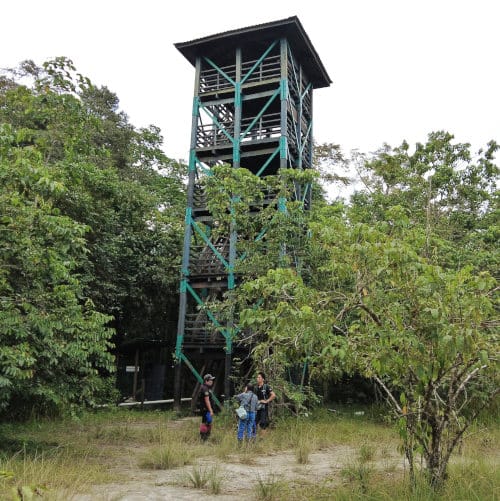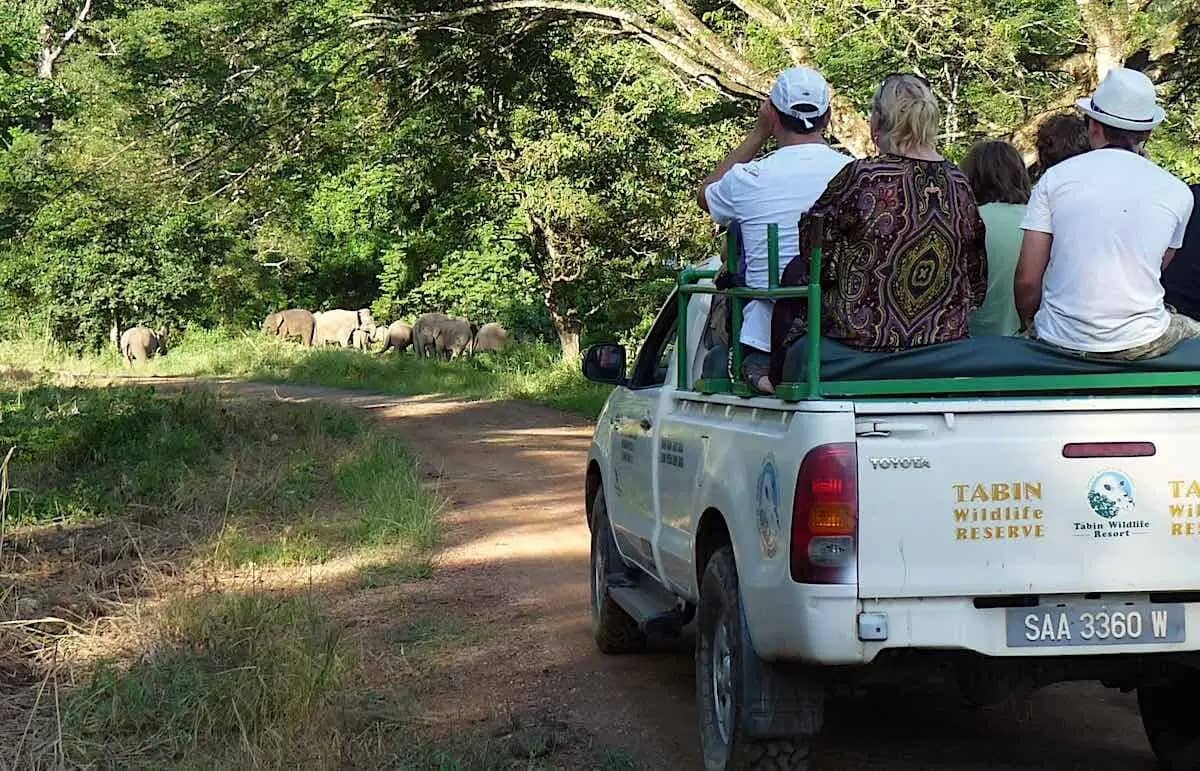As the biggest conservation area of wildlife within Sabah and Malaysia, Tabin Wildlife Reserve offers a great experience for wildlife lovers and bird watchers. As well, Tabin may act as an alternative to visiting the (expensive) Danum Valley or for those seeking a break after diving at the islands around Semporna. Continue reading to find out what makes Tabin Wildlife Reserve worth going to.
Tabin Wildlife in short
Located in the east of Sabah around 50 kilometers northeast of the town of Lahad Datu, Tabin Wildlife Reserve is the largest wildlife conservation area within the state of Sabah and Malaysia as a whole. As one of the last remaining areas of Sabah’s original lowland rainforest, Tabin was set up in 1984 to preserve Sabah’s disappearing wild animals. The reserve encompasses various habitats, including dipterocarp rainforest, mangroves, and limestone caves and covers an area of land two times the size of Singapore. It comprises both primary and secondary rainforests with trails mainly in the secondary rainforest. Hence, Tabin offers a different kind of experience than Danum Valley.
The wildlife at Tabin
Tabin Wildlife Reserve is known for its diverse range of flora and fauna, including some rare and endangered species like orangutans, Bornean pygmy elephants, clouded leopards, and sun bears. In fact, orangutans and sun bears from Sepilok are regularly released here, whereas the Sumatran Rhinoceros can no longer be found within Tabin.
Besides wildlife on foot, Tabin is a birdwatching paradise and home to over 300 species of birds. This includes all 8 species of hornbills, the endangered storm’s stork, blue-headed pitta, and Bornean bristlehead. Birdwatching activities is very easy along the jungle trails, from the observation towers, and even close to the reserve’s resort. In fact, many visitors mention that especially birdlife has been the highlight of going to Tabin.
Unique to Tabin are its mineral‑rich mud volcanoes that attract many wildlife that feeds on these minerals. These little volcanoes measure up to 2 meters heigh and erupt every now and then, with most recent eruptions taking place in 2014, 2019 and 2022. Besides wildlife on foot these volcanoes also attract many birds.
To observe wildlife, the reserve has some well-maintained observation towers that provide elevated views of the surrounding forest.

Within the reserve, Tabin Wildlife Resort is committed to sustainable tourism practices and conservation efforts, the resort aims to minimize its environmental impact. It does this through responsible waste management, energy conservation, and water-saving initiatives. Also, the resort supports wildlife conservation projects and educates guests about the importance of preserving the natural heritage of wildlife at Tabin.
Tabin Wildlife Reserve is dedicated to the conservation and sustainable management of its natural resources. The reserve plays a crucial role in protecting and preserving the habitat of endangered species, including the orangutan and Bornean pygmy elephant. Research and conservation programs are conducted within the reserve to study and monitor the flora, fauna, and ecosystems.
Much of Tabin’s forest has been selectively logged from the 1960s until late 1980s, apart from a central core of almost 9,000 hectares of pristine rainforest and several other smaller virgin jungle reserves. The rest of Tabin is covered by secondary (regrown) forest. The reserve is virtually surrounded by oil palm plantations.
Due to the exceptional diversity of flora and fauna, Tabin was recognized as vitally important for conservation. In recognition of this, two separate forest reserves were gazetted in 1955 and 1958. Finally, the two reserves were combined as one entity and re-gazetted as Tabin Wildlife Reserve in 1984.
Within Tabin, two Sabah government bodies are responsible for the preservation and conservation of the habitat. First of all, Sabah Wildlife Department has a vitally important role in protecting Tabin’s wildlife and conducting and coordinating research. Secondly, the Sabah Forestry Department ensures the protection of the forest habitat.
Tabin Wildlife Resort
As visiting the reserve is not allowed for a single day, going here requires booking a tour package with an overnight stay at Tabin Wildlife Resort. This resort, established in 1999, serves as a base for exploring the reserve and located on the western bank, beside the Lipad River and close to the palm oil plantations. The only road going here is a bumpy gravel road, going 45 kilometers northeast of Lahad Datu.
Accommodation and facilities
The resort houses 20 timber cabins comprising 10 river and 10 hill lodges that blend nicely into the natural surroundings. Both chalet types come with a balcony, facing the river or offering a panoramic view of the forest. The Hill chalets offer more privacy but are situated a little further from the main building of the resort and require going up some stairs by a timber boardwalk.
Interlinked with boardwalks to the chalets, the Sunbird Cafe facilitates all daily meals. Also this cafe is the center of all activities and acts as the reception to the accommodation. Just 10 minutes from the resort, the Visitor Center explains different types of wildlife and places of interest at Tabin Wildlife Reserve.
Many visitors recommend staying at least 2 nights with packages including all transfers, accommodation, meals, guided walks, and safari drives within the reserve. Upon check-in, a tour guide will go through the itinerary of the stay, practical information about the resort, and what to wear during the trips. For most, it seems that the resort aims to have a fixed guide allocated to visitors for the entire trip. This provides the best attention and addresses any questions during the stay.
Find out more about Tabin Wildlife Resort as well as the reserve via www.tabinwildlife.com.my/
What to do at Tabin
Discover more about the activities in and around the reserve below.

Jungle trekking and road safaris
The resort provides various wildlife encounters via guided jungle treks. These activities offer excellent opportunities to spot wildlife in their natural habitat.
Trails
Across the reserve there are 9 trekking trails and a number of roads used for four-wheel drive night safaris. The only way to use these trails is via a guide. The longest trail is the Gibbon Trail (2.8 km) which leads from the resort to Lipad Waterfall, followed by the Raleigh Trail (2.5 km) and Elephant Trail ( 2.2 km). Other trails are the Rhino Trail (1.8 km), Otters Loop (1.2 km), and Sambar Deer Trail (1.1 km). Some smaller trails are the Mud Volcano Trail (0.7 km), Otters Trail (0.5 km) and Mouse Deer Trail (0.4 km).

Night walks and safaris
A great time to see wildlife at Tabin is during night walks and safaris. This is when many nocturnal wildlife like owls, civet cats, clouded leopards, snakes and nocturnal birds can be spotted.

Mud volcanoes
Unique to Tabin are its natural hot springs known as mud volcanoes. These fascinating volcanoes are rich in minerals and serve as salt licks, attracting a range of wildlife that feeds on the mineral-rich mud. Hence, these mud bubble baths act as an essential source of minerals for the health of wildlife and offer great opportunities to watch animals.
The biggest and most accessible mud volcano is Lipad Mud Volcano around 2 kilometers from the resort. This volcano is also well visible using Google Maps. There is an observation tower and most tours visit the area to search for wildlife or look for animal footprints in the mud. The mud volcano is 2m in height and 20m wide.

Lipad waterfall
This waterfall is a great place to relax and cool down with a swim after a sweaty day. It is also called the ‘Twin-falls’ as an additional waterfall is created from time to time after a heavy downpour.

the majestically tall Tabin Giant Tree, known as Tualang or Mengaris
Together with Danum Valley, Tabin houses some of the world’s tallest tropical trees, measuring up to 90 meters. Although many prime rainforests with these trees are now protected, they are classified as endangered due to deforestation.
When to go
As with the rest of Sabah, the most popular time to visit Tabin is during the dry season, from April to October. This is also the best time to see orangutans during the fruiting season. This is primarily the driest period of the year, meaning that wild orangutans are more likely to gather around water and food sources. March to October is the best time of year to see proboscis monkeys and pygmy elephants. However, guides often recommend the period October to December to visit Tabin. During these months, there is usually more sunshine and the river levels will be lower. This means the animals have to come further out of their natural habitats in search of water and food, and therefore easier to spot.
On the contrary, the wet season from December to February may make outdoor activities more difficult but bring more beautiful natural scenery and fewer tourists disturbing the wildlife. Hence these times may be easier to spot animals and prices may be lower (no peak surcharges). Although birds can be seen all year round, October to April are the best months to spot (migratory) birdlife.
Despite the above, guides also mention any time of year is a good time to visit Tabin. This is because weather can vary from year to year and wildlife is random and cannot be controlled. Hence, you might be unlucky even during the best time of the year and always be ready to experience rain, no matter what time of year it is.
The ideal break after diving
According to the reserve, divers often visit Tabin after they have been on the islands around Semporna and diving at Sipadan and Mabul. This allows them to break the non-flying-after-diving rule.
How to get there
In order to get to Tabin Wildlife Reserve requires booking an overnight package at Tabin Wildlife Resort. This package includes a transfer to the resort from Lahad Datu, a small town on the east coast of Sabah and a main hub for palm oil within the region. The resort operates scheduled transfers from Lahad Datu to Tabin at 8 AM and 12 noon. The return transfer from Tabin to Lahad Datu departs around 13:30 PM. The road to the Reserve from Lahad Datu goes mostly via gravel, requiring a 4×4 wheeled car. The route goes along many palm oil plantations and secondary (regrown) forest and takes around 1.5 hours.
See below how to reach Lahad Datu for pickup to Tabin.
By flight to Lahad Datu
The quickest option to Tabin is taking one of the daily flights from Kota Kinabalu to Lahad Datu using MASwings (part of Malaysia Airlines). The flight takes approximately 1 hour. Conversely, from Sandakan, there is a daily flight to Lahad Datu that takes 35 minutes.
By road to Lahad Datu
Until Lahad Datu the roads are well-maintained from both directions north (Kota Kinabalu and Sandakan) and south (Semporna and Tawau).
Via Kota Kinabalu – Lahad Datu is approximately 400 kilometers and a 7-7.5 hour drive from Kota Kinabalu. Driving here allows to pass through other main highlights around Sabah like Mount Kinabalu, Sepilok and Sandakan, and the Kinabatangan River.
From Sandakan, it is a 4-hour drive to Lahad Datu whereas from Sukau at the Kinabatangan River it is a 2-hour drive.
From Semporna or Tawau going to Lahad Datu takes around 2-2.5 hours.



